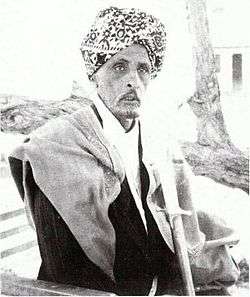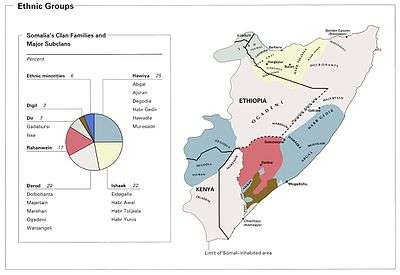Warsangali
The Warsangali (Somali: Qabiilka Warsangeli; Arabic: قبيلة ورسنجلي), (also Moorasaante/Awrkii Cirka, Warsengeli, Warsingeli, Oor Singally[1]) is a Somali clan family, part of the Darod.[2][3][4] In the Somali language, it means "bringer of good news."[1]
| Regions with significant populations | |
|---|---|
| Languages | |
| Somali | |
| Religion | |
| Islam (Sunni) | |
| Related ethnic groups | |
| Ogaden, Leelkase, Marehan, |
Warsangeli clan

An article titled "Seychellois rekindle ties with Sultan of Somaliland" which was featured in one of the newspapers of the Republic of Seychelles captures a glimpse of Warsangeli history. It writes, "the Warsengeli Sultanate has been in existence for the last six hundred years."[6] In 1848, C. J. Cruttenden reported that Warsangeli and Majeerteen territories were the most commercially valuable in the Nugaal Valley, and that Banians had become successful exporters.[7] The Cal Madow chain of mountains, which is partially inside the clan's territory, extends to the cities of Bosaso (the capital of the Bari region) and Ceerigaabo (the capital of the Sanaag region) in an east-west direction.

Notable members
- Mohamoud Ali Shire (1897–1960), leader of the Warsangeli sultanate; Sultan Mohamoud was exiled into Seychelles islands in 1920 for 7 years by the British Empire
- Abdillahi Mohammed Ahmed (1926-1993), known as Qablan, former Under-Secretary of Finance and former Minister of National Planning (1967 -1969)
- Farah Awl (1937-1991), writer
- Gerad Hamar Gale second Sultan of the Warsangali Sultanate
- Fatima Jibrell founder of the Horn relief now known as ADESO
References
- Cruttenden, C. J. "Memoir on the Western or Edoor Tribes, inhabiting the Somali Coast...". London: Royal Geographical Society. Vol. 19 (1849), pp. 72-73
- "Somalia: Minorities and indigenous peoples". Minority Rights Group International. Retrieved 22 September 2018.
- Lewis, Ioan M (1999). A Pastoral Democracy: A Study of Pastoralism and Politics Among the Northern Somali of the Horn of Africa. James Currey Publishers. p. 12. Retrieved 18 September 2019.
- Lewis, Ioan M (July 1959). "Clanship and Contract in Northern Somaliland". Africa: Journal of the International Africa Institute. 29 (3): 274. Retrieved 22 September 2018.
- Beachey, R. W. (1990). The Warrior Mullah: The Horn Aflame, 1892-1920. Bellew. ISBN 978-0-947792-43-5.
Sultan of the Warsangli since 1905 . Son of an Indian father by a Somali mother , he displayed much capacity for duplicity and double dealing .
- Seychellois rekindle ties with Sultan of Somaliland Archived 2007-09-27 at the Wayback Machine Virtual Seychelles. 10 Oct 2005.
- Cruttenden, C.J. (1848). "On Eastern Africa", London: Royal Geographical Society. Vol. 18, pp. 137-138.
- "Somalia Maps - Perry-Castañeda Map Collection - UT Library Online". Retrieved September 21, 2019.